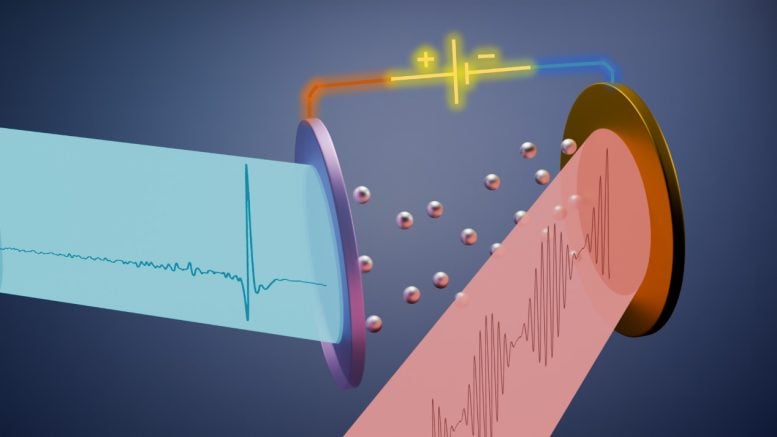
New research explores the Cherenkov effect where superluminal speeds generate radiation and discusses new research using this principle to create terahertz radiation for advanced imaging and radar applications.
When charged particles travel through a medium at a speed greater than the phase speed of light in that medium (a phenomenon known as superluminal speed), they emit radiation. The resulting radiation forms a conical pattern. This phenomenon, known as the Cherenkov effect, has numerous fundamental and practical applications. The explanation of this effect earned the Nobel Prize in Physics in 1958.
The oblique incidence of light on the interface between two media is a similar phenomenon; in this case, a wave of secondary radiation sources is formed along the interface, which propagates at a speed exceeding the phase speed of light. The refraction and reflection of light from an interface is the result of the addition of the amplitudes of waves from all sources formed during light incidence.
Electron Acceleration and Terahertz Radiation
If one considers the interface with photo emissive material — the cathode, on which light is incident obliquely and causes of electron emission, then an electron density wave will form along the cathode surface at superluminal speed. This phenomenon is accompanied by the generation of secondary radiation. The application of an external electric field leads to the acceleration of electrons and, as a consequence, an increase in the energy of electrons and secondary radiation for such sources.
Researchers from the Prokhorov General Physics Institute of the Russian Academy of Sciences have proposed using the formation of a superluminal wave of electron emission sources to generate terahertz radiation. The main idea is to apply ultrashort laser pulses to the surface of the cathode, which leads to the formation of an ultrashort electron bunch.
Next, the electrons are accelerated by an external field and abruptly stopped in a thin layer of dielectric, which leads to the generation of electromagnetic pulses in the microwave and in the terahertz range. The authors propose scaling such sources by increasing the efficiency of photo-emissive coatings. The results of this work open new sources of THz radiation for tasks of broadband noninvasive tomography, imaging, radar, and power effects on electronics.
\Reference: “Pulsed THz radiation under ultrafast optical discharge of vacuum photodiode” by Aleksandr Ushakov, Kseniia Mamaeva, Leonid Seleznev, Georgy Rizaev, Vladimir Bukin, Timophey Dolmatov, Pavel Chizhov, Vladimir Bagdasarov and Sergey Garnov, 13 June 2024, Frontiers of Optoelectronics.
DOI: 10.1007/s12200-024-00123-5
The study was funded by the Ministry of Science and Higher Education of the Russian Federation.
3 Comments
When charged particles travel through a medium at a speed greater than the phase speed of light in that medium (a phenomenon known as superluminal speed), they emit radiation. The resulting radiation forms a conical pattern. This phenomenon, known as the Cherenkov effect, has numerous fundamental and practical applications. The explanation of this effect earned the Nobel Prize in Physics in 1958.
Please ask researchers to think deeply:
1. What is the phase speed of light through a medium?
2. What is the phase speed of light in Einstein’s theory of relativity?
3. What is the difference between the phase speed of light through a medium and the phase speed of light in Einstein’s theory of relativity?
4. What is the physical essence of the phase speed of light in Einstein’s theory of relativity?
5. What is the faster speed in the real world than the synchronous effect?
6. How should we understand causality in synchronous effects?
7. Does light behave the same through different medium?
8. What medium does the speed of light through in Einstein’s theory of relativity?
9. Is the speed of light you measured in the experiment necessarily the speed of light in Einstein’s theory of relativity?
ang so on.
Scientific research guided by correct theories can help humanity avoid detours, failures, and pomposity. Please witness the exemplary collaboration between theoretical physicists and experimentalists (https://scitechdaily.com/microscope-spacecrafts-most-precise-test-of-key-component-of-the-theory-of-general-relativity/#comment-854286). Is this the children’s story of contemporary physics?
Misguided by the pseudo-scientific theory of Physical Review Letters (PRL), many researchers do not consider the similarities and differences between geometric shapes and physical reality in physics research, but indulge in imagination. Although scientific research can be imagined, it cannot be done recklessly.
It doesn’t work without the Smirnoff vodka, though.
pussian science has been used for murder and genocide for more than 100 years, so let’s boycott it!